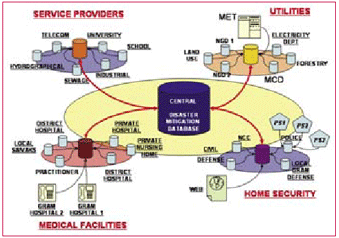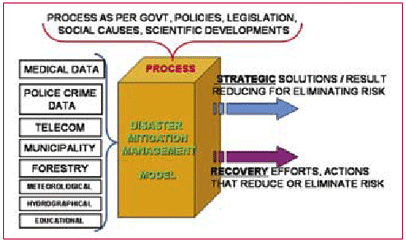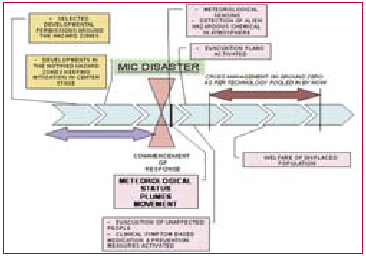| Mycoordinates | |
Integrated response system for disaster mitigation management
|
|||||||||||||||||||||||||
|
In recent past , humanity has suffered an increasing number of natural disasters affecting more than 2.5billion people, killing 478,100 and causing economic losses of about US$690bn (UNEP/ GRID-Arendal, 2005). Some of the distinctive instances are: December 2004 Indian Ocean earthquake and its concomitant tsunamis, The US eastern coast and Central America, hurricanes Katrina, Rita, Mitch, Stan and Wilma in September-October 2005, Pakistani earthquake of 2005, and now the current avian influenza in Asia and Europe. Natural and manmade tragedies, such as earthquakes, foods, nuclear catastrophes, pose an ever-present challenge to emergency services. Victims and societies at large have responded differently in each case. Some were heroic, some responsible but many panicked and responded irrationally. This aggravated the already bad situation. All of them could have responded more effectively if they were better informed and aright managed. It is clear that despite excellent efforts by many groups, the wealth of data residing with various organizations is not often effectively utilized in disaster management. Disaster management is not a linear process that can be documented easily in a flow chart with a readily apparent beginning and absolute end. Rather, it is a cyclical process of approximation, response and re-calibration that involves many different doers whose roles in relation to one another, are likely to dynamically change based on circumstances and the stage in the process. The one constant evident in the process is the chaos and entropy that drives the system of rules. The existing technology can provide disaster managers the important products that could save lives, reduce damage to property, mitigate overall damage, conserve resources and ameliorate human suffering. The current situation has many defects and has eclectic method for disaster management. To develop effective architectures and technologies that meet the needs of the disaster management there must be a precise understanding of the disaster management lifecycle. All the Communities must be synergized to define the disaster management system. They must necessary be associated with the cycle of data ontogenesis, dissemination, analysis and review. There should be an accurate understanding of the dynamics between these ingredients and the “interfaces” that this kinetics imply. Only with such an understanding, can we effectively pattern the process and derive technology solutions that map well into the business model of disaster management. The profile of a pre-disaster situation can be built in terms of four distinct groups; namely the hazardous entities, the victims, the intermediaries whose presence or absence can aggravate/ mitigate the impact of the disaster, agencies holding potentially useful information in disaster management. The paper discusses the construction such a profile by quantification of the disaster potential of the hazardous entities and the impact of the intermediaries. Enormous amount of information for such a vulnerability evaluation and disaster management is available disparate Governmental and public agencies. The paper proposes a framework for an online nodal agency for automated processing of all the data to build up such profiles. This can help in evolution of comprehensive disaster mitigation and management plans. The paper briefly discusses how such a system would have responded in situations such as Bhopal gas disaster Knowledge discovery for mitigationData integration Apart from the factual information from different agencies the disaster mitigation system must obtain the information on regulatory / standardization parameter from the appropriate authorities. The databases need to be talking in a real-time manner on a common platform. The data integration will require a certain level of standardization and compulsory data sharing. This requires a national level effort in the form of law enactment and clear regulations guiding everyone. Such a disaster mitigation authority may have a centralized or distributed architecture to handle the local disasters and the regional or national disasters. Hazard evaluation The vulnerability analysis The methodological challenge is to develop a reporting framework that can include qualitative, quantitative appraisal of vulnerability. Such an appraisal must be context-specific and linked to data on adaptive capacity. Ideally, vulnerability assessments should be continuously up-dated. Although assessments are often carried out at a particular scale, there are significant cross-scale interactions, due to the interconnectedness of economic, social, and environmental systems. Catastrophic value of hazard (CVH) Point catastrophic failure (PCF) value The methodology to evaluate the threat posed to the population, environment and various natural by the man-made hazards in tem of CVH and PCF values can be devised by, appropriate expert agencies. Different available methodologies / pattern must be compared, evaluated and updated on continuous basis. The disaster mitigation mechanism must use the factual data, regulatory / policy framework and the damage assessment methods (provided by experts). to generate the CVH, PCF and vulnerability values these values can be utilized on a real time basis. The CVH and PFC values can not only identify the current threat levels but also generate recommended set of actions. Insertion of any new hazard, intermediary, deviation from the standards, and change in the standards or the assessment methods will automatically lead to the reappraisal of the status. Hence the system functions like the conscious system capable of responding to the ever-changing surroundings. The system may run own housekeeping programs which continuously cross check the inputs provided by the different agencies and bring out the inconsistencies. Common determinations can be, that it is unyielding to assess CVH as an integral part of the causal chain of risk and to appreciate that changing vulnerability (conscious & awareness) is an effective strategy for risk management. Vulnerability analysis, along with conscious & awareness particularly those aimed at advancing sustainability can be identified by the following elements: – Multiple interacting perturbations and stressors/stresses and stressors/stresses and the sequencing of them; Case study: bhopal gas tragedyDescription * During the initial 48 hours following incident no measurements of atmospheric MIC were taken. Integrated mitigation response (IMR) * Storage of hazardous chemicals (High CVH) dangerously close to populated areas (High Vulnerability). It is quite likely that these cautions would have been ignored before the disaster. But they would have definitely help in more effective post disaster management / response in the following areas. * Identification / prioritization of the population requiring emergency evacuation. ConclusionPresently much of the effort to compile the data, carry out vulnerability, CVH, PCF value analysis looks like proverbial carving of the mountain in search of a rat. The truth is out there for anyone cares to see. There is a shortage of electricity, water supply is inadequate, malnourishment is common, crimes rampant, there is no approach road for the village, a fire tender can never hope to make its way through the maze of by lanes and yet the people are going about their life. The system must deal with the situation as is and not as it ought to be. The normal life with all its well-known problems is irreversibly damaged by the disaster. It creates waves like a stone thrown in the pond. The integrated disaster mitigation apparatus can generate more comprehensive as well as prioritized set of ‘things to be done’ in pre-disaster as well as post-disaster phases as against any manual system. The disaster mitigation machinery functions like war waging machine only with an opposite aim. Disaster mitigation management require a very coordinated and a rapid response. Today the technology offers us an unprecedented chance to rise to the occasion in a well thought out and transparent manner. Investment in this vital area will definitely save the societies and nations from a lot of death and destruction References * SOGOS – A Distributed Meta Level Architecture for the Self- Organizing Grid of Services” By C. Beckstein, P. Dittrich, Ch. Erfurth, D. Fey, B. K¨onig- Ries, M. Mundhenk, H. Sack |
|||||||||||||||||||||||||
|
|||||||||||||||||||||||||
|


















 (1 votes, average: 4.00 out of 5)
(1 votes, average: 4.00 out of 5)



